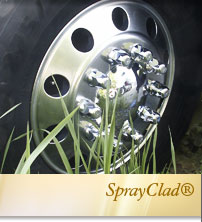
G.J. Nikolas & Co., Inc. |
Nikolas Vehicle Coatings
|
 |
|
 Description #12711 SC Brite Nickel AC is a liquid, spray on metallizing coating. Its appearance will simulate a chrome or polished silver finish. It can be applied to any substrate such as metal, wood, plastic or glass, and will produce a near mirror finish. #12711 SC AC is very versatile and can be used on small runs or large items and does not require special equipment. Suggested Uses: #12711 SC AC can be used in every industry; hardware, automotive, lighting, trophies, jewelry, fishing lures, statuary, picture frames, cosmetic containers, architectural metal maintenance and more. DOT SPECIFICATIONS: PAINT, 3, Flammable Liquid UN1263, PGII Benefits
Variations Nikolas makes three types of SprayClad for various requirements. #12711 SprayClad AC air dry should be used over #12667 Clear Eco-Thane or equivalent. #12596 SprayClad AC air dry will work without primer on ABS, acrylic, urethane plastic, as well as many metals and glass. #12691 SprayClad HC Bake bake at 275 degrees F for 30 minutes. Should be used over a baked basecoat. This version holds its brightness better than our other versions. Also works with Powder Coatings. Directions for Use: Base Coat Primer #12711 SC AC will metallize well on a variety of basecoats. Basecoats which will not re-dis- solve give the best results. Bakes, urethanes, and two part epoxies are all suitable, as well as many powder and e-coat basecoats. #12667 Clear Eco-Thane or #12559 Black Epoxy are well suited for basecoats. Both are two component coatings. Using a primer as a basecoat for SC AC is important for two reasons. First, it insures the best adhesion of the SC AC to the substrate. Second, it smooths any imperfections that may be present on the substrate such as casting or polishing marks. When used on basecoats that will re-dissolve, the metallizing effect of SC AC is disturbed when the solvents from the topcoat penetrate to the basecoat and re-solubalize the basecoat. This results in a muting of the shine, i.e. the metallizing effect is mostly lost. Directions for Use: Application Metallizing with #12711 SC AC is accomplished in three steps: Primer Coat, SC AC Metallizing Coat, and clear or toned Topcoat Primer Coat: For primer coat using Nikolas #12667 Clear Eco-thane or equivalent. Mix ratio is: nine parts #12667 Clear Eco-thane with one part Urethane Part B. Mix components thoroughly. Adjust atomizing air to 45-50 PSI, and apply. #12667 should appear glossy and wet, but be careful not to flood as runs and sags will occur. To air dry, allow #12667 to cure overnight before proceeding.To force dry, flash off 5 minutes then bake at 120 to 140° F for thirty minutes. Coating is cured after it has fully cooled. Metallizing Coat: Use #12711 SC AC after following step for primer coat. Mix SC AC thoroughly. SC AC is ready for use and further reduction is not recommended. SC AC is best applied at lower air pressures, typically around 25-35 PSI. Adjust the gun’s fluid output until it is closed and no material emits from the nozzle. Slowly open the gun until a light spray mist is produced. Begin coating the piece, lapping strokes between 50 to 75%. Applying SC AC in this manner will initially give a “dry spray” look, but will metallize within seconds and dry to a near mirror finish. Continue coating until the desired level of opacity is achieved. Depending on how much material is applied, a light dust of unfixed powder can form on the surface. This dust can be hard to see, however, lightly wiping with a soft cloth will reveal its presence. If the dust exists, it should be removed by continuing to wipe with a soft cloth. Allow SC AC coat to set 8 hours before proceeding. To force dry, flash off 5 minutes and bake between 120 to 140°F for thirty minutes. Fully cool to room temperature before proceeding. Clear or Tone Coat: Prepare clear lacquer or toner for spraying. Set air pressure between 45-55 PSI. Apply a thin wet coat, and allow coat to set at least 30 seconds. Apply a final full wet coat and allow to air dry overnite before packing or force dry as mentioned in previous steps. Product can be packed 1 hour after cooling if force dried. NikolasCentury, #12164 OD, and #12667 Clear EcoThane lacquers are all suitable for topcoating SC AC. Precautions Allow sufficient cure time between coats. Fully cured base coat and #12711 SC AC coat will hold the metallizing effect better than if the steps are rushed. A fine dust of unfixed powder can form on the surface of the metallizing coat. This powder can float into the topcoat, causing loss of shine, and must be removed by wiping with a soft cloth. To achieve any abrasion resistance, SC AC requires a clear or toned topcoat. Some brilliance of the metallizing will be lost when the topcoat is applied. This can be minimized by allowing full cure time of base coat and metallizing coat. Do not spray too heavy when applying first top coat pass. Allow the coat to flash off at least 30 seconds before applying a full final wet coat. Protective Equipment
Eyes: Safety glasses
Safety Keep away from heat, sparks, and flames. USE WITH ADEQUATE VENTILATION. Avoid prolonged or repeated contact with skin. Avoid prolonged breathing of vapor or spray mist. Do not take internally. KEEP OUT OF THE REACH OF CHILDREN. Before smoking or eating and after using, cleanse hands thoroughly. Keep container closed when not in use. Effects of Overexposure:
Skin Contact:
Inhalation:
These suggestions and data are based on information we believe to be reliable. They are offered in good faith, but without guarantee, as conditions and methods of use of our products are beyond our control. We recommend that the prospective user determine the suitability of our materials and suggestions before adopting them on a commercial scale.
|